Fall Tree Care Checklist
It’s official: Fall is here. With cooler weather on its way, now’s the perfect time to get your trees in tip-top shape and prep them for the winter months ahead. Use our handy checklist below to make sure your trees stay safe during the winter and thrive in the spring.
☑️ Rake
Disease-causing fungi love to hide under fallen leaves. And when the weather warms back up in spring, it awakens dead mold spores allowing them to re-infect your trees. Be sure to thoroughly rake your leaves during the fall to limit your tree’s chances of being infected.
☑️ Mulch
Adding a two to three-inch layer of mulch acts like a blanket for your tree and gives the roots an extra layer of protection during fall and winter. It has other benefits, too – like preventing evaporation, water runoff, improving water penetration to root zones and limiting weed growth that can also compete for water.
☑️ Water
We’re in a severe drought right now so it’s really important to water those trees! The best way to water is to put your hose on a slow trickle and let it cover the entire ground around the tree line (about 1-2 hours). With the drought we’re currently experiencing, it’s crucial to get water down into the soil and not just the top layer of the ground. To make sure you’re hydrating your trees effectively, we suggest:
- Watering in the morning
- Using a hose vs. a sprinkler
- Focusing on the critical root zone instead of foliage
- Making sure the soil is moist, not soaking
☑️ Plant
Fall is the best time to plant new trees. Since temperatures are much cooler, newly planted trees are less likely to suffer from sun scorch or drought – plus, they have the best chance to build root mass and prep for winter dormancy. Balled and burlapped trees and shrubs are best to plant in fall, while all bare root plants should be planted later in the season when they’re completely dormant. If you’re unsure what to plant, our experts at ArbTech are happy to help.
☑️ Inspect
The best time to inspect your trees for disease or structural issues is late fall when most of the leaves have fallen. If you do see any signs of damage or sickness, give us a call at 913-954-7004 so we can do a full assessment and provide any necessary treatment.











